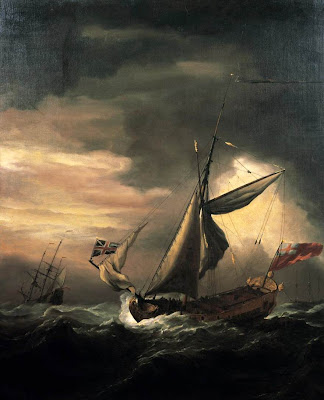
Oddly enough, the fine tradition of great maritime painting in England, epitomized by the many great seascapes of J.M.W. Turner, starts in Holland, in no small part thanks to Willem van de Velde the younger. van de Velde, who was baptized on December 18, 1633, painted many great scenes of Dutch shipping in his native Holland in the style of his father Willem van de Velde the elder, who brought his youthful experiences as a sailor to his art and then passed on the family business to his son. Calm: Dutch Ships Coming to Anchor (above), painted by van de Velde the younger sometime between 1665 and 1670, epitomizes the sleek finish and fine detail of his seascapes. Just as Dutch shipping ruled the waves at that time, so did Dutch painting of that industry.

van de Velde the younger, however, painted both war and peace—the two prevailing realities of seventeenth century shipping as the European sea powers vied for control of the markets and shipping lanes. The Cannon Shot (above, from 1670) shows van de Velde the younger’s ability to precisely render the appearance of the intricately masted and rigged ships of that era as they tried to obliterate one another. He chooses an interesting vantage point, perhaps from the perspective of another ship low in the water like that being rowed from the main vessel. van de Velde provides a great perspective on how these ships dwarfed the men serving upon them and how life seemed cheap in the pursuit of power and riches. van de Velde the younger followed the money and changed allegiances in 1673, moving to England to help his aging father paint British shipping in the service of King Charles II.

van de Velde the younger’s influence on later British painters such as Turner can be seen in works such as Shipping in Heavy Seas (above, from 1675). van de Velde’s troubled skies as emotional counterpoints to the plight of the British ship beneath, struggling amidst the turbulent sea, provided a case study for later British artists to follow. A proto-Romanticism rises from the depths of these storm scenes, which also hark back to the earlier Dutch painter Rembrandt and his Storm on the Sea of Galilee. I remember when the PMA tried to fill out the tragic 2004 Manet and the Sea exhibition with examples of Manet’s maritime inspirations such as van de Velde. I came away more interested in the inspirations than in what they inspired. Looking at van de Velde the younger’s work today allows us a glimpse into an age when ruling over the sea meant ruling over the land, which was as true in politics as it was in painting.




No comments:
Post a Comment